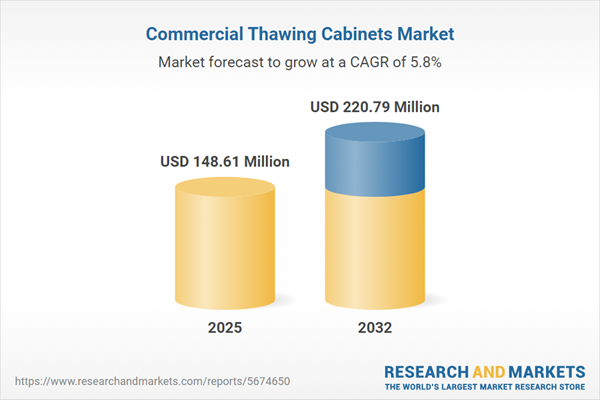Speak directly to the analyst to clarify any post sales queries you may have.
Commercial thawing cabinets are redefining foodservice operations for today’s senior decision-makers. As kitchens adapt to stricter standards and evolving workflows, these automated systems provide a pathway to greater operational control, food safety compliance, and resilience in fast-changing industry environments.
Market Snapshot: Commercial Thawing Cabinets Market Size and Growth
The commercial thawing cabinets market is demonstrating steady expansion, driven by growing demands for safer food handling, improved kitchen automation, and evolving labor trends. Current projections estimate market growth from USD 140.50 million in 2024 to USD 148.61 million in 2025, reaching a total of USD 220.79 million by 2032, at a CAGR of 5.81%. Senior procurement executives increasingly prioritize solutions that balance compliance, sustainability, and operational flexibility. This positions commercial thawing cabinets as integral to modern foodservice strategies, from global food chains to institutional kitchens.
Scope & Segmentation of the Commercial Thawing Cabinets Market
- Cabinet Types: Choose from compact countertop models for constrained spaces, single- or double-door reach-in cabinets for mid-sized applications, or walk-in versions—offered with solid or glass doors—for high-volume or specialized needs.
- End Users: Common adoption is seen in bakeries, restaurant groups, healthcare and education facilities, as well as quick service restaurants, all seeking consistent production, streamlined processes, and easier regulatory adherence.
- Operating Modes: Electric thawing cabinets suit urban operations emphasizing compliance, while gas-powered versions appeal in locations with energy limitations or specific utility considerations.
- Distribution Channels: Leaders access products via direct manufacturer contact, specialized distributors, digital procurement platforms focused on industry buyers, and third-party e-marketplaces according to local procurement habits and policy guidelines.
- Regions Covered: Major activity spans the Americas, Europe, Middle East, Africa, and Asia-Pacific, with each region utilizing market-tailored solutions for their distinct compliance requirements, infrastructure, and operational standards.
- Key Technologies: Solutions integrate digital temperature sensing, energy-saving compressors, refrigerants designed for environmental performance, remote system management, and modular designs that simplify facility upgrades and expansion.
- Leading Companies Profiled: Recognized manufacturers such as Rational AG, Welbilt, Inc., Electrolux Professional AB, Hoshizaki Corporation, GEA Group AG, The Middleby Corporation, Illinois Tool Works Inc., Ingersoll Rand Inc., Lincat Group PLC, and Fagor Industrial S. Coop provide global reach and expert regional understanding in the commercial thawing cabinets market.
Key Takeaways for Senior Decision-Makers
- Advanced automation and digital monitoring optimize preparation and storage, reducing manual supervision and ensuring consistent quality across multisite operations.
- Modular equipment designs support smooth adaptation to new menus, production rates, or kitchen layouts, helping organizations manage capital expenditures effectively.
- Incorporation of energy-efficient components helps enterprises advance sustainability agendas and control operational costs, particularly in highly regulated markets.
- Strategic collaboration and ongoing consolidation across the supply chain drive new advancements and enhance the accessibility of technical support and maintenance services.
- System integration with kitchen management software increases real-time visibility, simplifies preventive maintenance, and supports compliance reporting across different locations.
- Tailored market entry strategies foster resilience by aligning closely with local laws, purchasing preferences, and site infrastructure, supporting sustainable procurement over time.
Tariff Impact: Navigating Supply Chain and Cost Pressures
Recent changes in U.S. tariff policy affect the cost structure for essential metals and electronic components used in commercial thawing cabinets. Foodservice procurement leaders are responding by refining sourcing tactics, renegotiating supplier agreements, and rescheduling purchases according to market shifts. Ensuring consistent access to required equipment now hinges on robust supply chain analytics and flexible procurement models designed for ongoing market volatility.
Methodology & Data Sources
This analysis incorporates direct insights from executive interviews, end-user feedback from professional kitchens, and intelligence from product managers. Supplemented by technical white papers, compliance reviews, supplier reports, and evaluation of distribution networks, it ensures the market model is both current and robust.
Why This Report Matters
- Empowers foodservice leaders with in-depth knowledge to plan resource allocations and manage procurement decisions confidently across diverse enterprise settings.
- Supports technology and segmentation analysis, so investment strategies align with compliance needs, business priorities, and operational realities in every relevant market.
- Provides actionable evaluation of policy and supply chain developments, helping decision-makers protect against disruption and maintain procurement continuity.
Conclusion
This report enables leaders to proactively address regulatory changes, advance intelligent technology adoption, and navigate ongoing market shifts. The insights deliver a foundation for maintaining operational continuity and driving strategic enterprise growth in global foodservice.
Additional Product Information:
- Purchase of this report includes 1 year online access with quarterly updates.
- This report can be updated on request. Please contact our Customer Experience team using the Ask a Question widget on our website.
Table of Contents
3. Executive Summary
4. Market Overview
7. Cumulative Impact of Artificial Intelligence 2025
List of Figures
Samples

LOADING...
Companies Mentioned
The key companies profiled in this Commercial Thawing Cabinets market report include:- Rational AG
- Welbilt, Inc.
- Electrolux Professional AB
- Hoshizaki Corporation
- GEA Group AG
- The Middleby Corporation
- Illinois Tool Works Inc.
- Ingersoll Rand Inc.
- Lincat Group PLC
- Fagor Industrial S. Coop.
Table Information
| Report Attribute | Details |
|---|---|
| No. of Pages | 193 |
| Published | October 2025 |
| Forecast Period | 2025 - 2032 |
| Estimated Market Value ( USD | $ 148.61 Million |
| Forecasted Market Value ( USD | $ 220.79 Million |
| Compound Annual Growth Rate | 5.8% |
| Regions Covered | Global |
| No. of Companies Mentioned | 11 |









